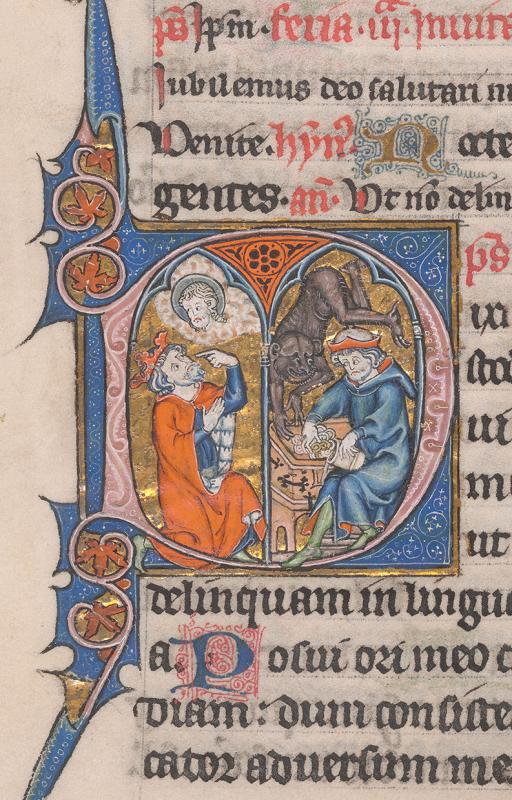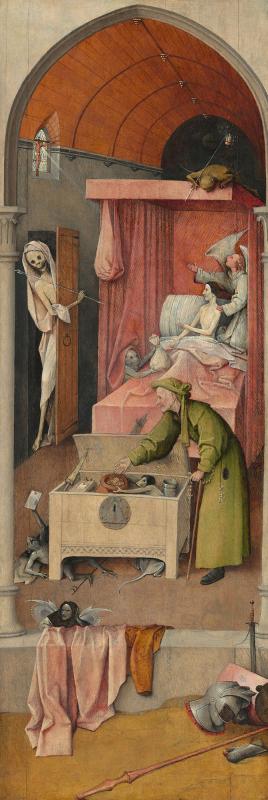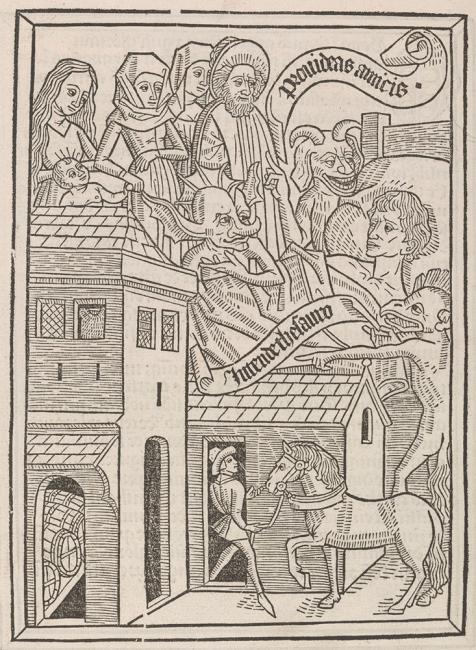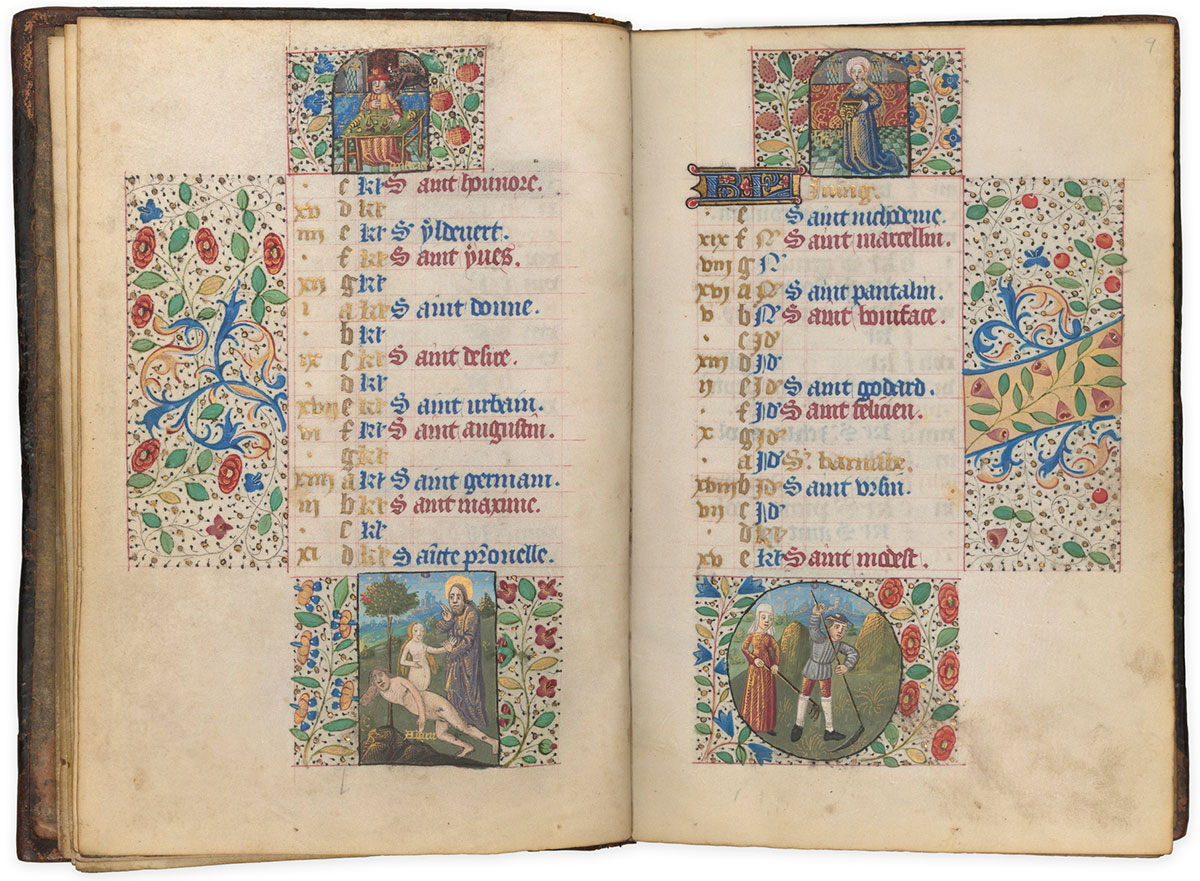This blog post is an excerpt by guest curator Diane Wolfthal from the catalogue accompanying the Morgan’s exhibition Medieval Money, Merchants and Morality.

Figure 3.6. David and an Avaricious Man, in an initial D from a breviary, France, Paris, 1285–97. The Morgan Library & Museum, New York, MS M.1042, fol. 29v.
The rise of the monetary economy transformed every aspect of European society, including its values and culture. From the late thirteenth to the early sixteenth century, western Europe, especially its major urban centers, was dramatically altered by the widespread use of money. A new mercantile class emerged that included bankers, money changers, pawnbrokers, and international traders. New financial practices developed, such as double-entry bookkeeping, insurance on shipping cargo, and the use of letters of credit and bills of exchange. Nicholas Oresme’s De moneta (On Money), dated 1356–60, inaugurated a new but increasingly popular genre, the monetary treatise. The needs of the growing merchant class also transformed urban spaces. Financial centers were established, such as the Beurse in Bruges, where Italian merchants lived and traded. New commercial networks developed that operated across vast areas, both within Europe (the Medici banks and the Hanseatic League) and beyond. As feudalism gave way to capitalism, vernacular writers like Geoffrey Chaucer, Giovanni Boccaccio, and François Villon revealed the richness and complexity of thinking about the monetary economy. The sound of money even shaped musical pieces. In fourteenth-century Florence, a madrigal by Lorenzo Masini made money audible by imitating the sound of clinking coins, and by suggesting the accumulation of wealth through the rapidity of its notes. Money flooded Europe, and, although some wished to separate the sacred from the profane, by the fourteenth and fifteenth centuries huge numbers of souvenirs were sold at pilgrimage sites and church fairs became major marketplaces. Money even crossed the boundary between this world and the next when it was buried in tombs.
But it was not simply money and its material culture that permeated medieval society: mercantile metaphors did, too. The merchant banker Cosimo de’ Medici (d. 1464) expressed religious concepts in economic terms when he complained that he could never spend as much to honor God as he found himself in God’s accounting books as a debtor. A French song about the Last Judgment, composed around 1500, ends each stanza with the phrase “to give an account and settle the balance,” meaning to confess one’s sins and repent. Similarly, the Breton Franciscan preacher Olivier Maillard (ca. 1430–1502) employed commercial concepts to make his theological ideas more accessible. He warned, for example, “The inheritance we purchase is paradise; the seller, that is God the Creator, places on us conditions, which are his commandments: if we leave out one, the contract is nul.” The language of economic transactions became so ubiquitous that it even colored the letters of the sixteenth-century Venetian courtesan Veronica Franco. In response to accusations of “cupidity,” she responded, “I plan to repay with my loyalty the debt of affection I owe you, exactly as if I were to return to you a sum of gold which you had lent me, by giving you an equal sum of silver or some other kind of money.”
Poverty was widespread in the Middle Ages, but a minority accumulated significant wealth. Among the most prosperous were the nobility, wealthy merchants, and the Church. But most people, even the poor, unless living in very remote areas, were directly involved in the monetary economy, and they learned of the debates about the value of money by hearing the sermons of mendicant friars and seeing the images in churches that condemned greed. The rise of the monetary economy sparked complex ethical discussions, which were rooted in the apparent contradiction between the Christian ideals of poverty and charity, on the one hand, and the pervasive role of money and the desire to accumulate wealth, on the other. Intense debates raged about the proper ways to earn and spend money. The thirteenth-century philosopher and theologian St. Thomas Aquinas expressed the dominant view when he wrote that trade “is justly deserving of blame, because, considered in itself, it satisfies the greed for gain, which knows no limit and tends to infinity.” As late as the early sixteenth century, Martin Luther agreed, arguing that “trade can be nothing but robbing and stealing the property of others.”
Although the Church recognized the positive good that wealth could contribute to society, and gradually accommodated its teachings to capitalism, fourteenth- and fifteenth-century merchant bankers were plagued by anxiety about some of their business practices. Tommaso Portinari (1428–1501), a Medici banker based in Bruges, voiced his discomfort with the profits that he made on bills of exchange, which permitted merchants to send money long distances where it was converted to local currency. Bankers charged a fee, presumably for the transfer and exchange of the currency, but in reality as interest on a loan. Since many considered bills of exchange to be usurious, Portinari downplayed his dealings in this questionable practice when he wrote, “The foundation of our business is in merchandise which absorbs most of our capital so that there is little left for dealings in exchange. . . . And dealing in commodities is certainly more honorable than dealing in bills of exchange.”
Medieval thinkers invited merchants to examine the fairness and communal benefit of even small everyday transactions. Following St. Paul (1 Timothy 6:10), Aquinas argued that greed was the root of all evil. He reasoned, “by riches man acquires the means of committing any sin whatever.” So common was this belief that it should not surprise us that of the approximately twenty punishments that Dante explored in his early fourteenth-century vision of hell, ten concern an excessive desire for riches. Medieval Christians understood the appeal of money, but also feared its dangers: material goods could enslave you, and avarice could lead to an empty, sterile life in this world and eternal damnation in the next.

Figure 3.1. Hieronymus Bosch, Death and the Miser, The Netherlands, ‘s-Hertogenbosch, ca. 1485–90. National Gallery of Art, Washington, DC, 1952.5.33.
The medieval Church condemned usury, which was initially defined as charging any interest on a loan. The Third Lateran Council of 1179 reminded Christians that the Bible outlawed usury, and proclaimed that “notorious usurers” should be denied both the Eucharist (the ritual consumption of the sacred host at Mass in commemoration of Christ’s death) and a church burial until they had returned the interest that they had charged their borrowers. It even forbade churches from accepting donations from usurers. Slowly, however, the Church accommodated capitalism, while still condemning excessive rates on loans. Artists and patrons grappled with issues of money and morality, and late medieval images reflected these economic debates. At least in part to expiate for the sin of usury, Enrico Scrovegni commissioned Padua’s Arena Chapel with frescoes by Giotto, Cosimo de’ Medici funded frescoes in San Marco in Florence, and Tommaso Portinari (the Medici banker mentioned above) donated Hugo van der Goes’s Portinari Altarpiece to the church hospital of Florence’s Santa Maria Nuova. Medieval Christians took seriously the biblical assertion that “You cannot serve God and mammon” (Matthew 6:24). This chapter examines the choice that many Christians faced, including members of the burgeoning middle class: should they accumulate wealth or save their souls?
Hieronymus Bosch’s Death and the Miser presents a clear choice between heavenly salvation and eternal damnation (Figure 3.1). As Death, a ghastly, shrouded skeleton, enters a bedchamber, a dying man must decide whether to accept the sack of money offered by a demon or to follow the counsel of the angel who urges him to fix his gaze on a crucifix that appears in the window. At the foot of the bed, a man, perhaps the same one in happier days, fingers a rosary while tossing coins into a pot held by a rat-faced demon. Two more demons slither under the chest, while a third, in the foreground, squatting near items that have been cast aside, seems to imply that armor, clothing, and weapons are ultimately worthless. Will the dying man choose money and condemn his soul to hell or will he embrace Christ so that his soul ascends to heaven? Bosch keeps us in suspense. The original composition, revealed by the underdrawing, shows the dying man accepting the moneybag from the devil while holding a costly vessel. Evidently, Bosch reconsidered this approach and instead depicted a moment of indecision, perhaps in order to prompt viewers to think about the choices they make in their own lives.
Bosch’s panel is suffused with money and its paraphernalia. The demon at the deathbed offers the man a closed sack. Its contents, however, are revealed through an artistic convention: coins press against the bulging bag, creating circular outlines. At the foot of the miser’s bed is a strongbox with a large lock. Lurking inside, a demon holds a pot of gold coins, into which a man tosses a couple more. A document sealed by red wax is stored inside the chest and another is held aloft by a nearby demon. These documents—perhaps mortgages, promissory notes, letters of credit, or bills of exchange—no doubt concern monetary matters.
Bosch’s painting draws on the text and imagery of the Ars moriendi (Art of Dying), which was probably written by a Dominican mendicant in the mid-fifteenth century. This extremely popular book survives in at least 300 manuscripts and well over 100 printed editions dating before 1500. Composed in Latin and translated into numerous vernacular languages, the Ars moriendi advises Christians how to resist temptation on their deathbeds so that their souls may enter heaven. As demons tempt a dying man to sin and angels inspire him to virtue, readers learn the path they must choose in order to attain salvation.

Figure 3.4. Temptation to Avarice, from Ars moriendi (Art of Dying), Germany, Augsburg (?), ca. 1470. The Morgan Library & Museum, New York, PML 273, fol. 10v (det.).
One edition of the text, a block book printed probably in Augsburg around 1470, includes five temptations: lack of faith, despair, impatience, pride, and avarice. A woodcut on the theme of avarice shows hideous demons tempting the dying man in order to distract him from thoughts of heaven (Figure 3.4). One demon, whose speech scroll, inscribed in Latin, states, “Pay attention to your treasure” (Intende thesauro), points emphatically to the man’s fine house, the garment displayed in its window, the well-stocked wine cellar, and the elegant groom and steed. Two other demons, whose speech scroll reads, “Provide for your loved ones” (Provideas amicis), gesture towards a group of figures, who gaze tenderly at the deceased. The accompanying text advises:
. . . now you will leave behind all the temporal goods which you accumulated through the greatest efforts and labors; you will leave behind also your wife, children, relatives, dearest friends, and all desirable things of this world . . . be extremely careful lest friends, wife, children, wealth, and other temporal things are remembered by anyone dying. . .
The influential contemporary Franciscan preacher Bernardino of Siena concurred, characterizing as sinful a dying man’s attachment to his family. But this idea goes back to Luke 14:26, “If any man come to me, and hate not his father, and mother, and wife, and children, and brethren, and sisters, and his own life also, he cannot be my disciple.” In short, being tied to earthly things, even to friends and family, could be deemed avaricious and a danger to one’s soul.
The mid-thirteenth-century Dominican William Peraldus of Lyon cautioned that demons, approaching the dying, would play on feelings of parental love, and, even when the dying were no longer interested in riches for themselves, they might want to retain them for their children. Usurers who left their profits to their heirs instead of making restitution to their borrowers risked damnation. Indeed, in the following woodcut, which shows the antidote to avarice, that is, detachment from worldly things, an angel shields the loved ones from the dying man’s gaze. The Ars moriendi presents a choice: embrace things of this earth (your possessions and your loved ones) or the salvation of your soul.
Diane Wolfthal, curator of Medieval Money, Merchants, and Morality
David and Caroline Minter Chair Emerita in the Humanities and Professor Emerita of Art History
Rice University

